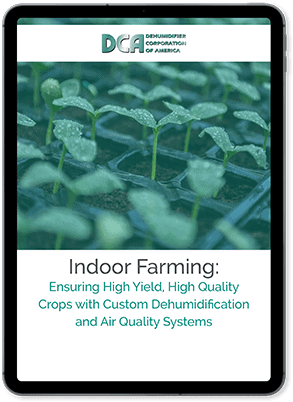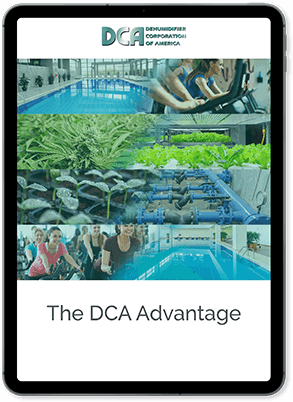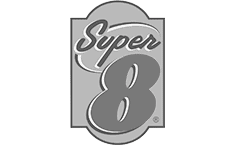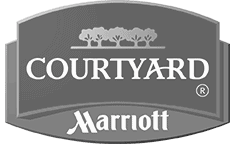Maximize Your Indoor Growing Season Productivity By Controlling Grow Room Humidity, Temperature And Hours Of Timely Applied Light
While controlling room temperature and light are important, controlling room relative humidity to coincide with the plant’s growth phase is key.
Indoor growers face a constant battle against humidity. Too much moisture leads to mold, mildew, and stunted growth. Too little causes poor development and reduced yields. Without proper dehumidification, you’re gambling with your entire harvest and investment.
DCA’s dedicated grow room dehumidification systems create “Mother Nature’s Best Day” for your crops—every single day.
The Challenge Every Indoor Grower Faces
You’ve invested thousands in your indoor grow operation. You’ve meticulously chosen lighting, nutrients, and irrigation systems. But without precise humidity control, all that investment remains at risk.
Indoor grow environments create unique challenges:
- Plants naturally release moisture into the air through transpiration
- Irrigation systems add substantial humidity to the environment
- Each growth stage requires different humidity levels for optimal development
- Moisture imbalance quickly leads to crop disease, reduced yields, and structural damage
- Each plant can have its own unique growth stage needs for maximum results
The success of your indoor grow operation depends on maintaining the perfect climate balance.
The Path to Consistent, High-Quality Harvests
A properly engineered dehumidification system is the difference between struggling with inconsistent results and achieving predictable, high-yield harvests month after month.
With the right custom DCA dehumidifier solution:
- Maintain perfect humidity levels throughout the entire growing cycle
- Create ideal conditions for seedlings (70-75%), vegging plants (50-70%), and flowering (40-50%)
- Prevent mold, mildew, and disease before they start
- Protect your facility from structural damage and maintenance issues
- Increase crop quality, potency, and market value
- Reduce energy costs with our efficient heat recovery options
Expert Solutions Designed Specifically for Indoor Growing
For over 45 years, Dehumidifier Corporation of America has engineered high-performance dehumidification systems for the most demanding environments. Our grow room solutions are built on decades of experience and designed specifically for the unique challenges indoor growers face.
Choose from customizable options to fit your exact needs:
- Horizontal or vertical configurations for any installation requirement
- Indoor, outdoor or roof installation capabilities
- Water source cooling or outdoor remote condenser for additional cooling
- Seamless integration with existing systems
- Remote monitoring and control options
- Made in the USA with non-proprietary components for easy maintenance
Finding Your Perfect Dehumidification Solution
Selecting the right dehumidifier capacity marks a critical decision point for your grow room’s success. Many growers make the costly mistake of underestimating their dehumidification needs, leading to persistent moisture problems that compromise crop quality and facility integrity. While a basic calculation can provide an initial estimate (number of plants multiplied by gallons of water per plant per day, then multiplied by 8 to convert to pounds per hour), the reality of indoor growing environments demands a more nuanced approach.
Your grow room’s unique characteristics significantly impact its moisture load. Room construction plays a fundamental role—spaces with proper vapor barriers require substantially different solutions than those with porous materials that allow moisture migration. The human element matters too; each worker introduces additional moisture through respiration and movement, with activity levels directly correlating to humidity increases. Even seemingly minor details like how frequently doors open throughout the day create cumulative effects on your environment’s stability. Equally important is having a grow room that is constructed with very little outdoor air infiltration. Normally, a well-insulated room with a non-permeable vapor barrier with taped joints and taped intrusions such as wall power outlets and light switches. A minimum of well-constructed outdoor facing windows with double or triple pain of glass is suggested as well.
Environmental factors external to your growing space cannot be overlooked. Geographic location, seasonal changes, and ambient humidity levels all influence the baseline from which your system must work. Advanced growing techniques introduce additional variables—CO₂ enrichment systems alter plant transpiration rates, various watering methodologies release different amounts of moisture into the air, and your chosen lighting configuration generates heat that affects evaporation patterns throughout the growing space.
Instead of leaving these complex calculations to guesswork, DCA’s engineering team offers comprehensive environmental assessments tailored specifically to your operation. Our experts analyze your unique growing environment, considering all relevant variables to design a dehumidification solution that maintains optimal conditions throughout every growth cycle. This consultative approach ensures you never pay for excess capacity you don’t need, while guaranteeing your system can handle peak moisture loads when it matters most.
Protected by Industry-Leading Warranties and Support
The reliability of your dehumidification system directly impacts your harvest consistency and quality. That’s why every DCA dehumidifier undergoes rigorous factory testing before installation, ensuring each unit delivers its specified performance under real-world conditions. We stand behind our engineering excellence with comprehensive warranty protection that exceeds industry standards—a full three-year warranty covering all dehumidifiers and remote condensers.
This exceptional warranty reflects our confidence in both design and construction quality. Unlike competitors who lock you into proprietary components and costly service agreements, DCA systems utilize non-proprietary parts readily available through multiple supply channels. This approach drastically reduces maintenance costs and minimizes downtime should service ever be needed. When technical questions arise, our experienced support team provides responsive guidance, often resolving issues without requiring on-site service calls.
Many of our earliest installations continue to perform flawlessly after decades of operation, a testament to our engineering philosophy that prioritizes durable construction and long-term reliability over planned obsolescence. In an industry where environmental control directly correlates with profitability, this reliability provides peace of mind that your growing operation will maintain optimal conditions year after year.
Special Considerations for Hydroponic Gardens and Indoor Growing Systems
Hydroponic growing environments introduce complex humidity management challenges that standard HVAC systems simply cannot address. These soilless growing methods create fundamentally different moisture dynamics that require specialized dehumidification approaches tailored to their unique characteristics. Understanding these differences is essential for maintaining optimal growing conditions that maximize yield, quality, and consistency in your indoor garden.
The Unique Humidity Challenges of Hydroponic Systems
Unlike traditional soil cultivation, hydroponic systems maintain plants in direct contact with nutrient-rich water solutions. This constant water exposure dramatically increases ambient humidity through both evaporation and enhanced plant transpiration. Nutrient solution temperatures—often maintained several degrees warmer than ambient air for optimal root function—accelerate evaporation rates and create persistent moisture loading throughout the growing space. This continuous moisture introduction requires precise dehumidification control calibrated specifically to your system’s design and scale.
The consequences of inadequate humidity management in hydroponic environments extend far beyond general discomfort. Root zones become particularly vulnerable to pythium and other water-borne pathogens when excessive ambient moisture prevents proper gas exchange at the root level. Plants often absorb significantly more water in hydroponic systems than in soil-based growing, leading to transpiration rates that can overwhelm standard environmental controls. Even minor fluctuations in reservoir temperatures can dramatically alter room humidity levels, creating conditions that favor pathogen development and stress plants during critical growth phases.
Grow Light Considerations Beyond Illumination
The sophisticated lighting systems employed in indoor gardens significantly impact moisture management strategies. High-intensity discharge (HID) lighting generates substantial heat that creates vertical temperature gradients throughout growing spaces. These temperature differentials directly affect humidity distribution, often creating pockets of excessive moisture around plant canopies while maintaining lower humidity levels near the floor. Without accounting for these stratification effects, even well-designed dehumidification systems may fail to protect sensitive flowering sites from condensation and associated fungal issues.
Even advanced LED systems, despite their improved efficiency and reduced heat output, create their own humidity management challenges. The directional nature of LED lighting can stimulate accelerated transpiration in plants directly beneath fixture arrays, creating localized humidity zones that require targeted air movement and moisture extraction. Effective dehumidification solutions must account for the specific evaporation effects of your lighting configuration, integrating airflow patterns that maintain consistent conditions throughout the entire growing space.
Propagation Areas: The Starting Point for Success
Young plants and cuttings present perhaps the most challenging humidity management scenario in indoor growing operations. These developing organisms require elevated humidity levels (typically 70-80%) to prevent desiccation while they develop functional root systems, yet these same conditions create perfect environments for damping off and other fungal pathogens that can devastate vulnerable young plants. Maintaining this delicate balance requires precise dehumidification control specifically calibrated to propagation environments.
Many growing operations benefit from segregated climate zones that maintain different conditions for plants at varying development stages. Propagation domes, while effective at maintaining humidity around cuttings, create moisture pockets that require careful monitoring and gradual venting to prevent pathogen development. Transitioning young plants from high-humidity propagation environments to production conditions demands gradual acclimation protocols supported by dehumidification systems capable of creating subtle humidity gradients that strengthen plants without shocking them.
Scaling Your Indoor Garden Successfully
As indoor growing operations expand, humidity challenges intensify exponentially rather than linearly. Increased plant density dramatically impacts moisture release through transpiration, often overwhelming environmental controls that functioned adequately at smaller scales. Multiple growing chambers, whether used for different crops or staging plants through various growth phases, may require integrated yet independently controlled dehumidification solutions that maintain ideal conditions for each specific environment.
The process of scaling up necessitates completely recalculating moisture loads and reassessing air movement patterns throughout the expanded facility. What worked perfectly in a smaller operation rarely translates directly to larger scales without significant reconfiguration. DCA engineers bring extensive experience with operations of all sizes, designing scalable solutions that accommodate both current needs and future expansion plans without requiring complete system replacements as your business grows.
Advanced Engineering Solutions for Modern Indoor Cultivation
At DCA, we understand that indoor growing represents a significant investment that deserves protection through precision environmental control. Our engineering team brings decades of experience specifically focused on the unique challenges facing commercial-scale indoor cultivation. This specialized expertise allows us to design dehumidification systems that integrate seamlessly with your existing infrastructure while delivering unmatched performance and efficiency.
Our approach begins with comprehensive environmental assessment rather than one-size-fits-all recommendations. We evaluate your specific growing methodology, facility construction, and production goals to develop custom solutions that address your unique needs. This consultative process ensures you receive a system precisely calibrated to your operation’s requirements—not an oversized unit that wastes energy or an undersized solution that fails during critical growth phases.
DCA dehumidification systems incorporate advanced features specifically designed for indoor growing applications. Our units can be configured with horizontal or vertical airflow patterns that complement your facility’s design and plant layout. Both indoor and outdoor installation options provide flexibility for facilities with limited mechanical space. Water-source cooling capabilities and outdoor remote condenser configurations maximize energy efficiency while minimizing heat introduction during sensitive flowering periods. Many operations benefit from our custom integration of outdoor make-up air systems that maintain optimal CO₂ levels while providing precise humidity control.
Beyond equipment specifications, our team’s deep understanding of plant physiology and growth requirements ensures your environmental control system supports healthy development through each cultivation cycle. This biological perspective distinguishes our approach from conventional HVAC providers who may understand mechanical systems but lack insight into the specific needs of high-value indoor crops.
Take Control of Your Growing Environment Today
The difference between struggling with unpredictable results and achieving consistent, profitable harvests and crop yield often comes down to greenhouse environmental control. Don’t let inadequate dehumidification threaten your indoor growing success. DCA’s custom solutions provide the precise moisture management your crops need to thrive through every growth stage, from propagation through harvest.
Request your free project analysis today and discover how our specialized dehumidification systems can help maximize your yields, quality, and profitability. Our engineering team is ready to develop a custom solution that addresses your specific challenges while providing the reliability and efficiency your operation demands.
























